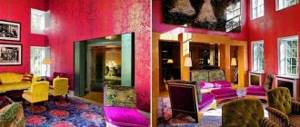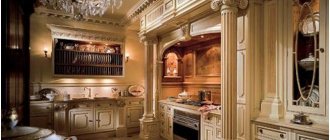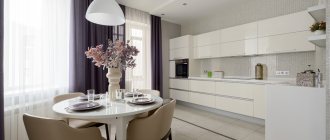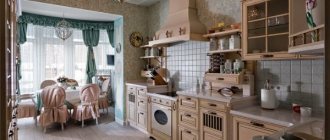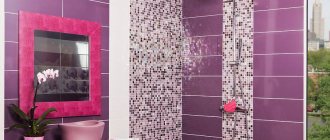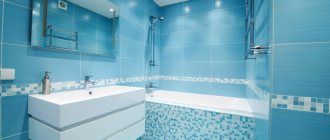Mosaic tiles for the bathroom are a finishing material that is a stylish and original solution that allows you to decorate rooms of different sizes. Its long service life and presentable appearance determine its high popularity in the modern world. However, choosing and laying this material is not an easy task, since mosaics require a special approach.
Small mosaic tiles are an ideal material for finishing bathrooms
Advantages and disadvantages of mosaic tiles
Like any other building material, mosaic has its advantages and some disadvantages. It has high strength and reliability. And also, which is very important, such tiles can be used in rooms with high levels of humidity.
Most types of mosaic tiles have common advantageous characteristics: reliability, durability, moisture resistance
Another advantage of this cladding is its resistance to temperature fluctuations. In the modern construction market, you can choose mosaics of different sizes, shapes and colors. Thanks to this, each person is able to purchase exactly the material that suits the design of a particular bathroom.
When choosing a mosaic for your bathroom, you should also remember that it is made from various materials. Each of them has its own characteristics. With the help of such cladding, you can decorate not only the vertical and horizontal surfaces of the room, but also individual interior elements.
Note! The small dimensions of the individual elements allow them to be placed on an uneven surface.
A positive point is the ability to install tiles on any surface, curved structures
The color of the mosaic is durable and does not fade over time, which is also a big plus. From a design point of view, this cladding is one of the most interesting. If necessary, small tiles can be combined and made into various patterns and designs.
However, using mosaic tiles for the bathroom also has its disadvantages. The main one is the difficult installation. This minus is also reflected in the cost of the work: laying such cladding by a master will be quite expensive. The price of the material itself is also high.
Mosaic tiles in the bathroom look much more attractive than traditional tiles
Types of mosaic tiles
In many ways, the design of the mosaic, as well as its performance characteristics, depend on the quality and type of materials from which it is composed. Mosaic tiles for the kitchen are divided into several options.
- Ceramics . The properties are practically no different from the large-format ceramics familiar to many, since it is made from molded ceramic tiles. But the mosaic is significantly superior to its analogue in its decorative properties and color range - in general, it resembles a handmade product.
Ceramic mosaics are made from the usual molded ceramic tiles
- Glass . The most popular type of mosaic tile due to its excellent decorative qualities and low price. Easy to maintain and has a long service life. Glass mosaic is much stronger than ordinary glass, which is achieved through high-temperature annealing.
Affordable price and excellent decorative qualities make glass mosaic one of the most popular materials for aprons
Glass material will be an ideal addition to a bright interior
- Stone . It is made from various rocks and minerals: from onyx to marble. This is an incredibly strong and durable material that only gets better over time. True, the price for it is very impressive - a square meter of mosaic will cost about 7,000 rubles.
Stone mosaic is one of the most expensive finishing materials
Stone is good to use in Scandinavian and country interiors
- Porcelain tiles . A good alternative to stone options. It is just as durable, but more affordable. It has a neutral color palette - from beige tones to dark brown shades.
Porcelain tile is not inferior in strength to stone, but is cheaper
- Mother of pearl . One of the most impressive options, capable of reflecting soft and subdued light from the surface. Mother-of-pearl mosaic shimmers with rainbow shades and looks incredibly stylish.
A mother-of-pearl apron will fill the kitchen with a pleasant shine
Mother of pearl is best combined with a light-colored set
- Metal . It can be made of rubber, plastic or ceramics, which are then covered with a layer of stainless steel, bronze or brass. As a result, the tiles acquire a steel or gold tint. This mosaic is reliable and practical, but the coating is still subject to gradual abrasion.
Metal mosaic - an option for modern kitchens
The metal surface is strong and durable
- Mirror . Made up of small pieces of mirrors. It has good wear resistance, but at the same time, instructions for its care require considerable effort. Most often, the shape of mirror chips is rectangular or square.
Gluing a glass apron will take a lot of time, but the result will be worth it
Mirror surfaces require special care
Mosaic in the bathroom: main types and characteristics
Such facing material is usually classified into varieties according to several criteria. The first one is form. Let's look at what these products could be:
- square;
- rectangular;
- round;
- diamond-shaped;
- multifaceted.
The unusual round shape of the mosaic looks very original and stylish in the bathroom.
The most commonly used are square and rectangular elements. Mosaics of this shape are a traditional solution for tiling surfaces in the bathroom. The original option is the use of elements that have an irregular shape.
Mosaics for the bathroom can have different sizes (from 1x1 to 5x5 cm). The classic option is to use 2x2 cm tiles. If necessary, you can also purchase mosaics assembled into blocks. It is a tile, 30x30 cm in size, which consists of a base (paper, rubber, etc.) and individual elements glued to it. The price of self-adhesive mosaic tiles for the bathroom is lower than individual elements.
Tile mosaics can come in a variety of sizes, depending on the location and purpose of installation.
An important criterion is the material from which the mosaic is made. In this case, there are several main options. The most common is mosaic made from ceramics. Glass elements, as well as smalt ones, are also popular. To emphasize the originality of the interior, you can purchase this type of cladding made from non-standard material (for example, wood).
Features of ceramic mosaic: photos and characteristics
As mentioned above, such tiles are the most popular among buyers. It is distinguished by its versatility and moderate cost. Elements made from this material have the same technical and physical characteristics as ordinary bathroom tiles. The main difference in this case is the dimensions.
Ceramic mosaic tiles have a wide variety of shapes, textures and colors
The surface of ceramic mosaic tiles can be different: glossy or matte. The first of them is made using glazing technology and is easy to maintain. Matte mosaic is more stylish; it is used for finishing mainly horizontal surfaces (floors), as it prevents slipping.
Helpful information! The surface texture of elements made of tiled material may also differ. On the market you can find products that imitate the surface of wood, stone, etc.
Ceramic tiles are considered one of the most popular low-budget options
Ceramic cladding has many advantages. A large assortment of such products determines their wide operational scope. Using ceramics, you can turn almost any design idea into reality. It is resistant to temperature fluctuations, resistant to humidity and easy to maintain. Mosaic tiles for a bathroom made of ceramic material are also fire-resistant.
This cladding looks good in combination with regular tiles. Its targeted use is a common design move that allows you to focus on a specific area of the room. If necessary, you can make such a cladding yourself from old or broken tiles. From a mosaic made with your own hands, you can also lay out a separate element, like a panel.
The ceramic surface of mosaic tiles is easy to care for using modern detergents
Glass mosaic tiles for the bathroom: photos and properties
Glass mosaic tiles are in second place in popularity among buyers. This type of cladding will cost less than ceramic cladding. It has the same technical characteristics as ordinary glass. However, there is one difference - the high strength of the tiles. Glass mosaic production technology takes into account the use of several materials, including:
- quartz sand;
- feldspar;
- dye (metal oxide).
During the manufacturing process, glass tiles undergo heat treatment, resulting in a very durable material.
In order to obtain this type of cladding, melting technology is used. The next step is stamping. At the end of the process, the resulting elements are hardened by firing. Thus, glass mosaic tiles for the bathroom become highly resistant to mechanical stress (impacts).
Glass elements are distinguished by a presentable appearance and are presented on the modern market in a variety of colors and textures. Products can be glossy or matte. Transparent glass mosaics are very popular.
Glass mosaic tiles are highly resistant to steam and moisture and are particularly hygienic.
This type of lining is resistant to bacteria, so the possibility of fungus developing on its surface is practically reduced to zero. It is heat and moisture resistant and easy to care for. It is worth mentioning separately that glass mosaics can withstand not only high but also low temperatures.
Tiles made from this material are most often used for wall cladding, but they can also be laid on the floor. Mosaics for horizontal surfaces must have anti-slip properties.
Smalt mosaic tiles for the bathroom: photos and advantages
The facing material made from smalt is distinguished by its unique properties. The production technology of such mosaics includes several stages. First, the material is pressed, after which the glass particles, colored with dye, are fused into individual elements.
Smalt is interesting because it is opaque, but seems to glow from within
Bathroom mosaics made of smalt are used in rooms subject to increased load. Thus, we can conclude that this material has a high strength coefficient. The advantages of such cladding also include resistance to low temperatures and active chemical compounds.
Note! Products made from smalt, like glass mosaic tiles, can be used to decorate swimming pools.
Smalt mosaic is opaque, but its peculiarity lies in the play of light. If you look at a single element of such cladding, you will notice the effect of light emitting from within.
Smalt mosaic has a very smooth and pleasant to the touch surface, from which any dirt can be easily removed
Today, the construction market offers a wide range of mosaics made of smalt. The shape and size of these products may vary. The main disadvantage of smalt cladding is its cost, which is higher than that of glass.
Stone mosaic tiles for bathroom
This cladding is made from different types of stone. It could be marble or granite. And also quite often on the market you can find products made of jasper and slate. Stone mosaic has a presentable appearance and can decorate any bathroom interior.
Stone tiles are durable and resistant to various mechanical influences, so they can be used as flooring
To increase the aesthetic effect, finished stone elements undergo additional processing. Small elements are ground, polished or artificially aged. This production technology contributes to the production of unique cladding that looks great on walls and floors. For clarity, it is recommended to study the corresponding photos. Stone mosaic tiles are used not only for complete cladding. With its help you can highlight individual elements of the interior and place accents.
The technical characteristics of stone tiles are determined by their origin. It can be used in rooms with high humidity. It is not afraid of temperature fluctuations and is fireproof. This material is excellent for cladding surfaces both inside and outside the house.
The color of natural material is unique, so each mosaic image is unique
Appearance and high technical characteristics affect the price of mosaic tiles of this type. It is very expensive (especially marble). There are options where you can save a lot of money. For example, elements made from pebbles have proven themselves to be excellent, and this material, if necessary, can be collected for free on the seashore.
Metal mosaic tiles for the bathroom
This mosaic appeared not so long ago, but has already found its buyer in the construction market. This type of cladding is made from a variety of metals, but the most common is steel. Brass mosaic tiles are no less popular.
Individual elements, which can have different sizes, are fixed to a special base. It is usually made of flexible materials (for example, rubber). There are many types of metal cladding for the bathroom, which differ not only in size, but also in shape. In specialized stores you can find elements in the form of triangles, hexagons, irregular geometric shapes, etc.
Helpful information! It is important to remember that such cladding requires special care. It is strictly not recommended to wipe such tiles with chemical compounds that include abrasive particles.
Metal mosaic is considered one of the rarest, but at the same time spectacular options.
The metal cladding surface is also classified into several types. It can be glossy or matte, and also have a certain texture. Photos of mosaics for a bathroom of this type will help you make the right choice, so it is recommended that you familiarize yourself with them.
Mosaic tiles for the bathroom: non-standard solutions
Mosaics for bathroom cladding can also be made from other, less traditional materials. For example, if you want to save your finances, you can purchase plastic-based tiles. Products made from polymers are much cheaper, but they do not have such high technical properties. This mosaic does not look so impressive, but is quite suitable for cladding horizontal and vertical surfaces in damp rooms.
The use of glass mosaic in the interior is now very popular; such decoration can give the space an extraordinary and mysterious character.
One of the advantages of polymer cladding can also be noted that it adheres very well to almost any surface. In addition, it can be used as mosaic floor tiles. The surface of the polymer mosaic is not as slippery as that of tiled cladding. A non-standard but effective solution is to purchase and lay mirror tiles. Its production technology involves processing individual fragments of the mirror surface. It is most often used to highlight some element in the interior of the bathroom.
If necessary, you can purchase a mirror mosaic with silver or gold plating. You can buy mosaics for a bathroom of this type in a specialized store or place an order online. The cost of such material is quite high.
The least common is mosaic tiles made from wood. It appeared on the market quite recently. Rare, expensive tree species are used in its production. The use of such cladding allows you to cover the walls of the bathroom with small tiles of different shades. Of course, this solution is the most original.
Wooden mosaic tiles require special care and are not fire resistant. It also does not have the same resistance to moisture as other types of these products.
Wooden tiles are not recommended for finishing particularly wet rooms, but can be installed as small decorative elements
Materials
The modern world gives us not only freedom in choosing interior design, but also a variety of materials in which to embody our ideas. A kitchen apron can be made from mosaics not only in different shapes, but also from different materials. What are the most popular materials for making mosaic matrices?
- Ceramics . The advantages of ceramics are obvious - high wear resistance, a wide range of colors, and the ability to be used in any style. Using ceramics, you can imitate any surface; it can be glossy or matte, smooth or rough.
Glass . Glass panels are cheaper than ceramic panels, but are not inferior to them in strength and wear resistance. It's all about high-temperature firing, which makes glass mosaics stronger than ordinary glass. A glass splashback can become an accent in a monochrome kitchen, because due to the refraction of light it can play with different colors and shades. Glass can also be glossy, matte, transparent, as well as with the addition of metals, glitter, foil and other materials.
- Mirror mosaic will allow you to create a real disco kitchen! It is made from pieces of mirror, approximately 5 mm thick. They are also resistant to mechanical damage no worse than glass and ceramics. An apron made of mirror mosaic will visually expand the space and will look great in interiors in Art Deco, Modern and High-Tech styles. Alas, in warm classic interiors such a solution will not always be appropriate.
- has no analogues in its properties . Stone mosaic will last forever and add solidity to the interior. For use in the kitchen, you should prefer the least porous stone - marble or granite. These stones will not absorb odors, but they remain unstable to dyes, so they should be treated with special impregnations before installation.
- To feel like a chef in a real five-star kitchen, you can complement the stylish steel set with a metal mosaic . It is made of rubber or ceramics, and is coated on top with a thin layer of stainless steel, bronze or brass. In terms of wear resistance, it is inferior to all the materials mentioned above, but has a stunning appearance. In the Loft, Modern, Hi-Taek style you cannot do without a metal apron.
Interesting article: How to choose an MDF kitchen apron?
Reference! Before giving preference to one or another type of tile, it is worth asking the price. The cost of some types may be an unpleasant surprise. In this case, it is wiser to choose a more affordable analogue with a similar coating.
Varieties of mosaics by type of base
Before purchasing, it is recommended to pay attention not only to the outer part, but also to the base of the mosaic. The bathroom is a room with high humidity, so the material for its cladding must be chosen with special care. Let's consider what basis mosaic tiles can be placed on:
- mesh;
- paper;
- without a base.
Thanks to the mesh base, the mosaic is easy to cut
Mosaic tiles on the grid. In this case, individual elements are fixed on a special grid. They are arranged in a certain order, forming the necessary pattern. Rectangular or square blocks, consisting of individual tiles assembled in succession, are excellent for installation on any surface. They can be laid on uneven walls by adjusting the distance between the elements.
Mosaic tiles on paper. A base made of such material facilitates quick and accurate laying of the tile block. The paper is fixed on the front side of the mosaic, which allows you to maintain the required arrangement of individual elements.
Paper-based mosaic is very convenient and easy to install
Helpful information! After laying such a cladding, it is necessary to remove the paper from its surface. To do this, it is moistened with warm water.
Mosaic tiles without base. It is used quite rarely for installation in bathrooms. Products without a base are usually used to organize beautiful panels. For such work you must have certain qualifications. Therefore, for self-installation it is better not to use a scattering of tiles. It is also worth mentioning that today you can buy ordinary tiles made to look like mosaics. It looks presentable on the walls in the bathroom, and its installation is much easier. You can buy mosaic tiles in a specialized store or online.
To lay mosaic tiles without a base, you need to have certain qualifications
Features of laying mosaics in the kitchen
Working with mosaic tiles for the bathroom, kitchen and other rooms consists of several stages:
- preparatory;
- selection of materials;
- installation of elements;
- grouting joints.
The quality of foundation preparation directly affects the result of the work. At the first stage, a metal spatula is used to remove the old coating. You may also need a hammer, hammer drill and other working tools. Putty and plaster are used to mask wall unevenness. To glue the mosaic, you will need a good adhesive to ensure a secure hold. Grouting compound is used to mask the seams.
There are several features of laying tiles on a kitchen apron:
- The laying of any tile is carried out horizontally, which allows you to achieve perfect evenness and accuracy.
- The first row is laid vertically. This will serve as a guide for further rows.
- Each plate must be thoroughly coated with glue.
- You can use a grid, which simplifies the installation of the mosaic. In this case, you will initially need to glue the mesh to the wall, and then lay tiles in the cells.
Mosaic tiles in the bathroom: design, photo
The appearance of such cladding is influenced by several main factors. These include: material of manufacture, front side processing option, size, shape and installation method. In order to perform original wall and floor cladding in the bathroom, it is necessary to take into account all these criteria.
Mosaic tiles themselves are a material that, after installation, looks presentable and stylish. The use of such cladding is more popular than the creation of a classic panel. This is due to its reasonable cost and relatively simple installation. Let's consider what mosaic design options in the bathroom exist today:
- single color;
Mosaic is one of the most common decorative interior decorations
- background;
- gradient;
- mix;
- panel
Single color. In this case, tiles of the same shade are laid on a vertical or horizontal surface. Most often it has the same size and shape. This design solution is suitable for creating a minimalist bathroom.
Advantageous combination of black and white mosaic mix in the bathroom
Single-color mosaics are also often used to create a bright stripe or geometric shape on the wall. Such a move in the interior affects the visual change in the proportions of the room, which is characteristic of the Art Nouveau style. Another option is to use cladding that is non-standard in shape, but of the same color and size.
Background. This bathroom design option involves using tiles of the same or different sizes. Their combination should not form a clearly defined pattern. It is worth noting that such a design solution can be either monochromatic or colored, as well as with a pattern.
Background mosaic tiles for small bathrooms create an interesting textured surface without a pattern
Gradient. An original and stylish bathroom design with mosaics. The peculiarity of this solution is the smooth transition of shade from one edge of the wall to the other. This method of laying mosaics is usually used in cases where it is necessary to visually expand the space or increase the ceiling.
Mix. From the name it becomes clear that this design method takes into account a combination of different shades. The individual cladding elements in this case have the same shape and size. In the case of laying dimensional mosaics (at least 5x5 cm), this method makes it possible to use elements with a pattern or imitation.
A tile stretcher is a mosaic panel on which one color smoothly transitions to another
This type of cladding is very popular in the construction market due to its favorable cost. If you are interested in the question of how to decorate a bathroom, then this option is one of the most suitable.
Panel. An effective design solution that requires professional skills. Mosaics can be used to create real works of art that will last for many years. The shape of individual facing tiles in this case can be very different, as well as size and color.
The panel, made using the matrix assembly technique, is an image made from a mosaic
Note! The individual tiles that are used to organize panels are small in size. They are not assembled into blocks, so they can be laid on a curved surface.
There is an option that involves the use of block mosaics. It is more popular because it requires less installation skills and is cheaper. In turn, manual installation requires both professional training and large financial costs. However, a hand-assembled panel is the most spectacular interior design solution you can make. Panels are often used in combination with background mosaics in the bathroom. Photos of designs of different types will allow you to clearly appreciate the beauty of a particular installation method.
Bathroom tile design: choosing colors
Before you buy mosaic tiles, you need to decide on its color. Which shade should I choose? Experts recommend paying attention to colors that are close to nature. They are most often the focus of attention in the modern world. These can be brown, blue, beige and gray shades.
A wall decorated with a textured mosaic that imitates stone or wood looks original. The ideal solution for a bathroom is to lay tiles made from natural stone. If you lack funds, you can also use less expensive artificial stone.
If there is enough light in the bathroom, then its walls can be safely decorated with black tiles
The use of multi-colored mosaics is very popular. A bathroom decorated in different shades looks stylish and pleases the eye. However, it is necessary to remember that in this case it is strictly not recommended to combine more than three shades.
When choosing suitable tones, it is advisable to take into account the rules for their combination. For example, designers advise marking one color as background. The other two will also perform a specific function. The second color will become complementary, and the third will place the necessary accents in the room.
White tiles for the bathroom will always remain relevant, because this color has always been the basic and common design option for the room.
For the bathroom, it is advisable to choose a pastel shade as the background. The additional color in this case should be brighter. Individual elements can be decorated in a more contrasting shade. In any case, before deciding on the design of the room, it is recommended to pay attention to the photo of the bathroom tiles. Mosaic can both decorate a room and “oversaturate” it.
A win-win solution - white mosaic. Such a room will always look stylish. Therefore, if you cannot decide on the variety of colors, then opt for white tiles. It has another significant advantage: water stains are not so visible on it.
You can create a unique exclusive interior in your bathroom thanks to bronze mosaic tiles
How to choose a mosaic for the kitchen
You have decided to create a mosaic backsplash for the kitchen. It's so easy to get confused by the variety of options in stores. How to choose and what you should know before buying a mosaic? Pay attention to the following critical factors:
Material
Depending on the material used, the mosaic for the apron can be of the following type:
- ceramic - produced in the form of small tiles with an edge size of 10 cm, as well as large products stylized as mosaics;
- glass - produced on a large and flexible base, characterized by high moisture resistance and fits perfectly into modern interior solutions;
- metal - made on the basis of a ceramic base, harmoniously emphasizes the Art Nouveau style;
- stone - most often complemented by ceramic and glass elements, characterized by increased strength and durability;
- materials interspersed with shells, smalt and other elements are bright accents in expensive designer interiors.
Size and shape
Mosaic cladding is made up of individual elements. They are called chips. The size of the cells can vary from 1x1cm to 10x10 cm. In the process of arranging a kitchen, the most common chips are from 2x2 cm to 5x5 cm. The most popular shapes are squares, rectangles, hexagons and rhombuses.
Mosaics are not sold individually, but in the form of a matrix. This makes the installation process easier. The standard matrix size is 30x30 cm. Mosaic parts can be fixed with polymer bridges and attached to a polyurethane mesh or paper base.
Design
Once the size and shape of the mosaic tiles have been determined, you can begin to develop the design of the apron. It comes in several types.
- Monocolor - a mosaic panel consists of modules of the same shape and color.
- Mix - a composition of mosaic tiles includes different shades of the same color. In this case, modules of the same format are used. The number of colors and shades in the mix affects the cost of the apron.
- Stretching or gradient - distinguished by a rectangular shape and a special arrangement of colors: from slightly saturated to the brightest shade.
- Panel - the presence of a pattern or design in a mosaic composition. This is the most expensive and exclusive option.
The mosaic tile materials chosen have a direct impact on the possible design.
Review of popular mosaic installation options
There are several ways to lay mosaic tiles. Some are more traditional, while others are used on rare occasions. Let us consider the installation options for this facing material in more detail.
Basic (mesh). This method is popular because it is the simplest. In this case, the mosaic wall tiles are laid parallel to the plane of the wall itself. It is also worth noting that the seams between the individual elements with this installation take on the shape of a mesh. This installation method allows you to use not only classic tiles.
The basic method of laying mosaics in the bathroom is the simplest and most common.
Helpful information! For laying with mesh, it is best to choose cladding of one shade. The use of multi-colored elements is not recommended, as they distract attention from the seams.
Basic (angular). This method is also common and involves laying individual mosaic elements in a diamond pattern. They are glued to the wall at a certain angle, which is 45°. This arrangement of the mosaic allows you to visually align the walls if they are curved.
The basic (corner) method involves laying individual mosaic elements in diamond shapes
It is also worth noting that corner laying contributes to the visual expansion of the room. However, there are some disadvantages to this installation. The main one is the need to cut the material to fit it. Designers recommend using one or two shades when covering walls in this way. There are other bathroom renovation ideas, but in any case you cannot combine more than three colors.
Chess. Laying mosaics in this way is similar to the first option (basic). The difference in this case lies in the location of the seams and the colors of the individual facing elements. With this installation, two mosaic colors are used, which must be contrasting with each other. And the seams are arranged sequentially, without displacement. The checkerboard version is often used for laying relief tiles that have notches. Alternating horizontal and vertical stripes create a stylish and interesting finish.
The linear method of laying tiles involves installation in rows that differ in texture and shade from the main background
Linear. The technology for such installation is carried out in the same way as in the first case. It differs from the basic method only in that it involves the installation of rows that differ in texture and shade from the main background. This installation is most often used to decorate bathrooms in a modern style (for example, high-tech).
Take a running start. Used when laying mosaic tiles on the floor or wall. It is another variation of the traditional basic style. In this case, the mosaic is laid with a mixture of exactly half of one facing element. The effect that is achieved when installed staggered gives the cladding the appearance of a brick wall.
The method of laying mosaics in a staggered manner gives the cladding the appearance of brickwork
In some cases, other technologies are also used for laying mosaics: modular, parquet, relief, etc. However, the most common options for laying such tiles today are listed above. You can buy mosaics for the bathroom in a specialized store, a construction hypermarket, or order online.
Advantages and disadvantages
Any interior solution has both pros and cons, and mosaic on a kitchen apron is no exception. Today, mosaic is literally experiencing a rebirth after a long period of oblivion. Why is she so loved by designers and housewives around the world?
- This is a very durable material. The mosaic is made of highly durable materials that are not easily damaged. The mosaic doesn’t care about temperature changes.
- This apron is easy to care for. Some types can even be cleaned with abrasive materials without fear of damaging the surface. With the right choice of grout, the apron will be completely impervious to moisture, acids and other substances.
- This is a stylish solution for any interior. Lined with mosaics, the kitchen apron will become the accent that the kitchen may have been missing. As mentioned above, it can be used everywhere.
Interesting article: How to choose a kitchen apron based on HDF
The disadvantages of mosaics include purely practical aspects of its use, for example:
- High cost of material . Some types of mosaics can be very expensive. It is quite difficult to save on such material, but it is possible. Keep an eye out for sales, and also look out for defective lots that are available in any store. In some interiors, small imperfections are appropriate.
- Difficulty in installation . Laying simple tiles is not easy, but mosaics are several times more difficult. Of course, due to its structure, some flaws will not be noticeable, but if you strive for ideality, it is best to invite a professional.
- The characteristics of the grout require the presence of a large number of seams. In this regard, only epoxy grout should be used to protect the finished product from moisture. Epoxy grout is not cheap, so laying mosaics can be several times more expensive than regular ceramic tiles.]
Types of mosaics
The main difference between mosaic and other types of tiles is its size. As a rule, it has a regular square shape and a size of no more than 2 cm. Designer collections represent original production lines in which tiles of other geometric, and sometimes even abstract, shapes are acceptable.
This is done to create an individual design, so most of them are still small, classic sizes.
There are only two gradations due to the fact that the universal one can be used even for decorating walls, even for niches, even for the ceiling, but special requirements are imposed on the floor.
It must be resistant to mechanical stress, moisture and not slip even when wet. For this purpose, special compositions are used in production, and the surface itself has a matte appearance with notches and a certain roughness.
Mosaic tiles are sold individually and require very painstaking work during installation. For the purpose of convenience, as well as for selling a complete color or patterned panel, it is often applied to special plates that have an adhesive or mesh base.
Such a base has the size of a large tile, for example 20x20 or 20-40, and can also be the size of the picture presented at the exhibition. This design will significantly reduce installation time, and make the process less labor-intensive and simplify it.

